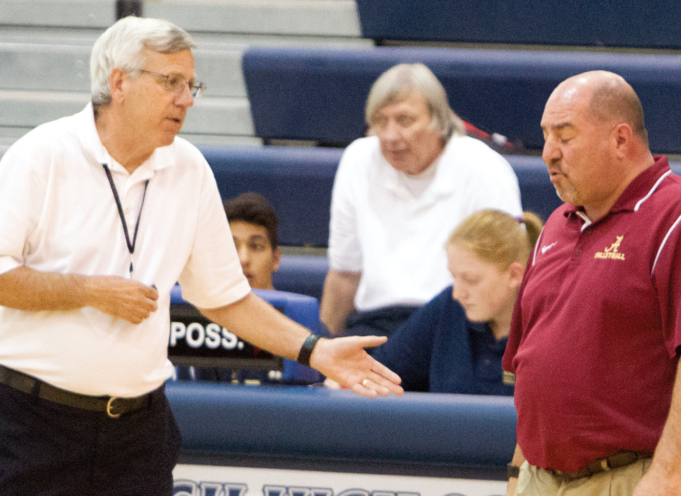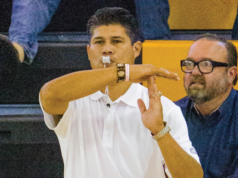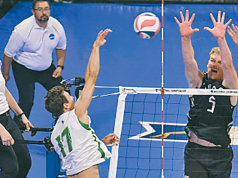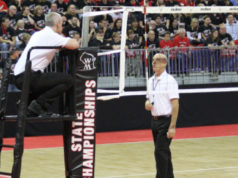A successful second referee needs strong speaking and listening skills. They must possess thorough rules knowledge that allows for quick, accurate answers during the heat of battle when it comes to interacting with a coach. And they must have a keen awareness of oncourt actions, which puts them in a good position to understand what, when and how to respond to a coach’s concern.
How can you embrace those sometimes awkward or uncomfortable occasions and turn a challenging situation into an opportunity?
It starts with understanding that as second referee, you are the primary voice for the officiating team. The first referee has verbal communication with team captains from time to time, but other than that, his or her communication is done with whistles and signals. When further explanation is needed, you will likely be doing the speaking. The conversation may be with a coach or a captain, or maybe another member of the officiating team. Be prepared, warm up your vocal chords and grab the bull by the horns.
Your awareness of oncourt actions will put you in the best position to respond to a coach’s question. Use the philosophy of not responding to a coach with, “I’m sorry, I didn’t see the play.” Instead, work hard to see as much of the playing action as possible without sacrificing your primary duties during a rally. Primary duties come first. Learn when you can glance away from the net and centerline to see where the ball is and who’s playing it. By seeing as much of the playing action as possible, while still staying on top of your duties, you’ll be in a better position to answer a question at the end of a rally.
Be on the alert for plays that may result in a question from a coach. Back-row faults almost always elicit a coach’s reaction. A net that is bouncing up and down during a rally will get a coach off the bench, even if he or she didn’t see what caused the net to bounce. Tight net plays that result in a “reaching over” call will surely cause a coach to get up to defend a player’s action. And ballhandling calls (or no-calls), especially when the player uses an unorthodox technique or body position, may bring a coach to the point of wanting a discussion with you.
With those scenarios on your mind, the next step is to anticipate the potential questions. When the rally ends, recognize that the coach who lost the rally may be seeking an explanation of the call/no-call. There’s a fine line between inviting a conversation (by looking directly at the coach at the end of an unusual or controversial decision), and being aware of the situation and preparing to take action if needed.
Depending on the circumstances, you may need to go into “serve and protect” mode. We don’t want a coach yelling across the court to the first referee. If it appears that may occur, begin moving toward the coach who is approaching the sideline or substitution zone. Your presence may divert the question to you instead of your partner across the court. If it doesn’t, move nearer to the coach and redirect the question by asking the coach what you can help with or answer.
Listening skills and knowing what just happened on the court will be your most valuable assets at that moment. While you should assume the coach’s question may be about the play that just occurred, be sure to listen first. The question may not be what you’re anticipating. If you over-anticipate the question and don’t hear what the coach says, you may end up answering a question that wasn’t asked. That could open up an entirely different can of worms.
When responding to the coach, use verbiage from the rules when the question is rule-related. Briefly state what happened on the court and highlight the rule(s) that apply. Back-row plays often need a quick clarification. It’s important to state some key phrases so that the coach knows 1) you understand the rules, and 2) you saw what happened. For example, after calling a back-row block on the setter, you can quickly state, “Coach, your setter is back row. The ball entered the plane of the net and the opponent legally blocked it as your setter was trying to save it. Since she was reaching higher than the top of the net when the ball was blocked back into her, by definition, she is considered a blocker.”
If a rule isn’t the issue, be clear in recapping what you saw. If, for example, the coach questions a net fault decision, it’s important that you don’t rattle off a quick, “There was no net, coach.” Due to your position at the moment of the play, there may be times that you may not see everything. Also, recognize that the coach is viewing the court from a different angle than you. Instead of “No net, coach,” it might be better to say, “I didn’t see a net fault from my position, coach. I’ll keep a close eye on it for you.”
Ballhandling decisions can be a little trickier to address with a coach, but it’s often a good idea to remind the coach that the first referee’s view from the stand was different than his or her view from the bench. Again, using rules verbiage such as “caught, thrown” are important. And with a multiple contact, keep in mind that is legal on any first team contact. “Spin is not illegal” may also be useful when the ball spins after being released, but there was no discernable multiple contact. And with USAV and NCAA rules, athletic or spectacular plays sometimes earn leniency when it comes to ballhandling.
To excel as a second referee, you need to accept the challenges that sometimes come with communicating with coaches. By having solid rules knowledge, understanding what happened on the court and using good listening skills, you’ll be able to be “the voice” for the officiating team and interact professionally with bench personnel.
What's Your Call? Leave a Comment:
Note: This article is archival in nature. Rules, interpretations, mechanics, philosophies and other information may or may not be correct for the current year.
This article is the copyright of ©Referee Enterprises, Inc., and may not be republished in whole or in part online, in print or in any capacity without expressed written permission from Referee. The article is made available for educational use by individuals.


















